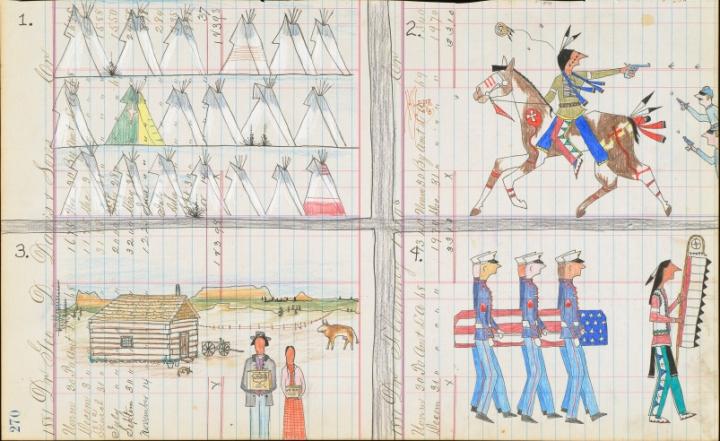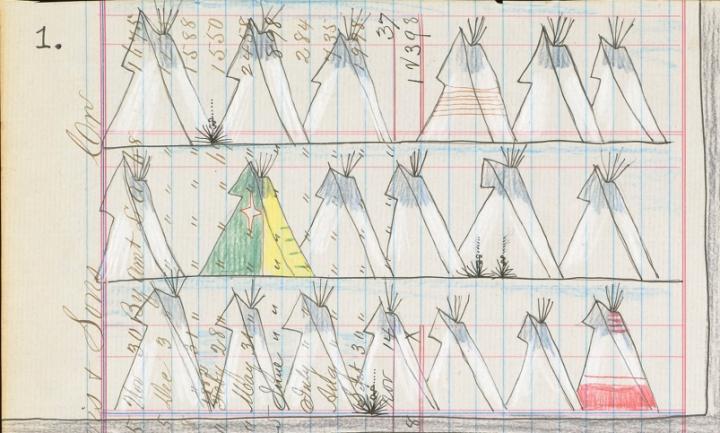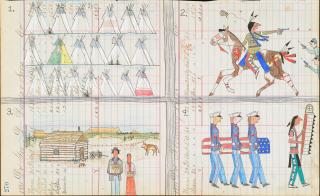
Dwayne Wilcox, Oglala Lakota, From Here to Eternity, 2008, crayon, colored pencil, and felt-tipped pen on ledger book paper. Purchased through the Guernsey Center Moore 1904 Fund; D.2008.59.3.
Based on the Learning to Look method created by the Hood Museum of Art. This discussion-based approach will introduce you and your students to the five steps involved in exploring a work of art: careful observation, analysis, research, interpretation, and critique.
HOW TO USE THIS RESOURCE
1. Print out this document for yourself.
2. Read through it carefully as you look at the image of the work of art.
3. When you are ready to engage your class, project the image of the work of art on a screen in your classroom.
4. Use the questions provided below to lead the discussion.
Step 1. Close Observation
Ask students to look carefully and describe everything they see. Start with broad, open-ended questions like:
* What do you notice when you look at this image?
* What else do you see?

Become more and more specific as you guide your students’ eyes around the work with questions like these:
* What materials were used to make this work of art?
* Can you read the words written on the lined paper underneath the drawings?
* How would you describe the artist’s style?

* How is this drawing organized?
* What is going on in each quadrant of the work?
Step 2. Preliminary Analysis
Once you have listed everything you can see about the object, begin asking simple analytic questions that will deepen your students' understanding of the work.
For instance:
* The paper in this work of art seems to have been used before. Can you guess by whom? For what?
* Why might a Native American artist want to draw on top of a piece of paper that has been written on by a European American?
* Do the four images in this work tell a story? If so, of what?
* Does the artist have a point of view in this work? An opinion?
After each response, always ask, "How do you know?" or "How can you tell?" so that students will look to the work for visual evidence to support their theories.
Step 3. Research
At the end of this document, you will find some background information on this object. Read it or paraphrase it for your students.
Step 4. Interpretation
Interpretation involves bringing your close observation, preliminary analyses, and any additional information you have gathered about an art object together to try to understand what a work of art means. There are often no absolute right or wrong answers when interpreting a work of art. There are simply more thoughtful and better informed ones. Challenging your students to defend their interpretations based upon their visual analysis and their research is most important.
Some basic interpretation questions for this object might be:
* Dwayne Wilcox's work consciously mimics the tradition of ledger drawing that dates back to the middle of the nineteenth century, and before that to a tradition of drawing on rocks, buffalo hides, and tipis.
* Compare Dwayne Wilcox's image to a ledger drawing made in 1860. (An image is included at the end of this resource.) How are they the same? How are they different?
* With their ledger drawings, Native peoples were creating a visual "record" of their history on top of a written record of European American affairs. Why do you think Dwayne Wilcox wanted to copy this style of art making in the twenty-first century?
* What does this image seem to be saying about the intertwined history of Native Americans and European Americans?
Step 5. Critical Assessment and Response
Critical assessment and response involves a judgment about the success of a work of art. This step optional but should always follow the first four steps of the Learning to Look method. Art critics often engage in this further analysis and support their opinions based on careful study of and research about the work of art.
Critical assessment involves questions of value. For instance:
* Do you think this work of art is successful and well done? Why or why not?
This fifth stage can also encompass one’s response to a work of art. One’s response can be much more personal and subjective than one’s assessment.
* Do you like this work of art? Does it move you?
* Are the ideas in this image powerful to you?






Background Information
Dwayne Wilcox, Oglala Lakota, born 1957
From Here to Eternity, 2008
Crayon, colored pencil, and felt-tipped pen on ledger book paper
Purchased through the Guernsey Center Moore 1904 Fund; D.2008.59.3
Ledger drawing is an art form in which Native American artists draw images on paper, often taken from European American accounting, or ledger, books. It is connected with the tradition of Plains Indian art in which images of war and hunting were inscribed onto rock, buffalo hides, and tipis by warrior-artists to memorialize their accomplishments and to designate their positions in the tribe. As increased contact with Euro-Americans from the 1850s through the 1870s led to the transformation of life on the Great Plains, these male warriors-artists turned to drawing on the balance sheets in ledger books that they obtained from white settlers, traders, and the military. Recognizing that ledger books were used to record important information, Natives appropriated them as a means to keep track of heroic deeds, recording battles between Natives and non-Natives as well as nostalgic scenes of pre-reservation life. During the reservation era these drawings continued to serve as personal narratives but also as a chronicle of the transitions brought on by captivity, life on the reservation, and the subjugation of Native cultures. Contemporary ledger artists use visual storytelling as a means of exploring both their cultural heritage and issues of present-day Native experience.
Dwayne Wilcox's drawings apply a satire and irony to the challenges facing Native Americans and reveal Wilcox's keen sensitivity to Native life, both historic and contemporary. In this four-part composition, he presents a visual narrative of the transition from pre-reservation life to the present-day reality of many Native Americans. In the first panel, located in the upper left, he depicts a Native encampment prior to European contact. The second panel, in the upper right, depicts Natives fighting for "what little they had to lose—everything." The third panel, in the lower left, shows a reservation-bound Native couple with the man holding a box containing government rations. The fourth panel, in the lower right, alludes to the disproportionate number of Natives that have served in the military relative to all other ethnic groups. As Wilcox states, "A lot of young Native boys are fighting for their country's freedom and they still don't have their freedom, and there's no American dream waiting for them when they return."
Contemporary ledger artists like Dwayne Wilcox celebrate the cultural perseverance and survival of this art form through deliberate references to historic ledger drawing in their own work. These works often critique the contested histories of Native America and explore issues of Native identity. Some contemporary ledger artists use historical photographs and documents as a means of reassessing and reclaiming their family and tribal histories. Others, like Wilcox, use ironic humor to compel the viewer to confront cultural stereotypes.